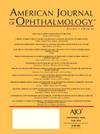Association Between Long-Term Ambient Air Pollution and Primary Open-Angle Glaucoma: A Nationwide Cohort Study in Taiwan
IF 4.1
1区 医学
Q1 OPHTHALMOLOGY
引用次数: 0
Abstract
Objective
Glaucoma is a leading cause of irreversible blindness worldwide, with incidence expected to increase with the aging global population. In this study, we aimed to investigate the association between long-term exposure to ambient air pollution and the risk of primary open- angle glaucoma (POAG).
Design
Retrospective, nationwide, population-based cohort study.
Participants
The study included 590,338 individuals aged 20 years and older who had no prior diagnosis of glaucoma and at least 10 years of air pollution exposure data. Seven air pollutants were examined: sulfur dioxide, carbon monoxide, particles less than 10 micrometers in diameter, particles less than 2.5 micrometers in diameter, nitrogen oxides, nitrogen monoxide, and nitrogen dioxide.
Methods
We utilized data from the National Health Insurance Research Database (NHIRD) in Taiwan. Participants were followed from January 1, 2000, to December 31, 2013. To assess the association between air pollutants and POAG risk, air pollution data were linked to patients' residential postal codes recorded in insurance registration records. The cumulative daily average level of each pollutant was calculated for each participant over the 10-year exposure period.
Main Outcome Measures
The primary outcome was incident POAG, which was defined as patients who received an ICD-9-CM diagnosis code for POAG confirmed by an ophthalmologist during at least 2 outpatient visits, along with POAG treatment. Hazard ratios (HRs) for exposure at each standard deviation increment over ten years were calculated using Cox regression models adjusted for confounding variables.
Results
During the follow-up period, 3158 patients with POAG were identified (0.53% incidence). A 1-standard-deviation increase in the 10-year average pollutant level was associated with a significant increase in POAG risk, ranging from 40% to 108%. This association was consistently observed across pollutants, with the highest risk linked to carbon monoxide exposure; meanwhile sulfur dioxide showed the lowest increase.
Conclusions
Long-term exposure to air pollution is significantly associated with an increased risk of POAG. These findings highlight the critical need for further research and public health interventions to mitigate this risk, particularly in regions with high pollution levels.
长期环境空气污染与原发性开角型青光眼的关系:台湾一项全国性队列研究。
目的:青光眼是世界范围内不可逆失明的主要原因,随着全球人口老龄化,青光眼的发病率预计会增加。在这项研究中,我们旨在探讨长期暴露于环境空气污染与原发性开角型青光眼(POAG)风险之间的关系。设计:回顾性、全国性、基于人群的队列研究。参与者:该研究包括590,338名年龄在20岁及以上的人,他们之前没有青光眼的诊断,并且至少有10年的空气污染暴露数据。对二氧化硫、一氧化碳、直径小于10微米的颗粒、直径小于2.5微米的颗粒、氮氧化物、一氧化二氮和二氧化氮等7种空气污染物进行了检查。参与者从2000年1月1日到2013年12月31日被跟踪调查。为了评估空气污染物与POAG风险之间的关系,空气污染数据与保险登记记录中记录的患者居住邮政编码相关联。计算了每个参与者在10年暴露期内每种污染物的累积日平均水平。主要结局指标:主要结局指标为POAG的发生率,定义为接受ICD-9-CM诊断代码的POAG患者,该诊断代码由眼科医生在至少两次门诊就诊期间确认,并接受POAG治疗。使用校正了混杂变量的Cox回归模型计算10年内每个标准差增量暴露的风险比(hr)。结果:随访期间发现POAG 3158例,发生率0.53%。10年平均污染物水平每增加一个标准差,POAG风险就会显著增加,增加幅度从40%到108%不等。这种关联在各种污染物中都得到了一致的观察,与一氧化碳暴露有关的风险最高;而二氧化硫的增幅最低。结论:长期暴露于空气污染与POAG风险增加显著相关。这些发现突出表明,迫切需要进一步研究和采取公共卫生干预措施,以减轻这种风险,特别是在高污染地区。
本文章由计算机程序翻译,如有差异,请以英文原文为准。
求助全文
约1分钟内获得全文
求助全文
来源期刊
CiteScore
9.20
自引率
7.10%
发文量
406
审稿时长
36 days
期刊介绍:
The American Journal of Ophthalmology is a peer-reviewed, scientific publication that welcomes the submission of original, previously unpublished manuscripts directed to ophthalmologists and visual science specialists describing clinical investigations, clinical observations, and clinically relevant laboratory investigations. Published monthly since 1884, the full text of the American Journal of Ophthalmology and supplementary material are also presented online at www.AJO.com and on ScienceDirect.
The American Journal of Ophthalmology publishes Full-Length Articles, Perspectives, Editorials, Correspondences, Books Reports and Announcements. Brief Reports and Case Reports are no longer published. We recommend submitting Brief Reports and Case Reports to our companion publication, the American Journal of Ophthalmology Case Reports.
Manuscripts are accepted with the understanding that they have not been and will not be published elsewhere substantially in any format, and that there are no ethical problems with the content or data collection. Authors may be requested to produce the data upon which the manuscript is based and to answer expeditiously any questions about the manuscript or its authors.

 求助内容:
求助内容: 应助结果提醒方式:
应助结果提醒方式:


